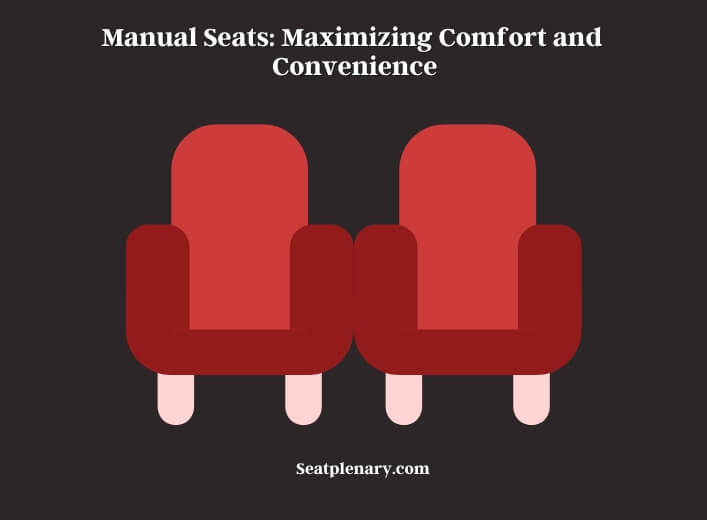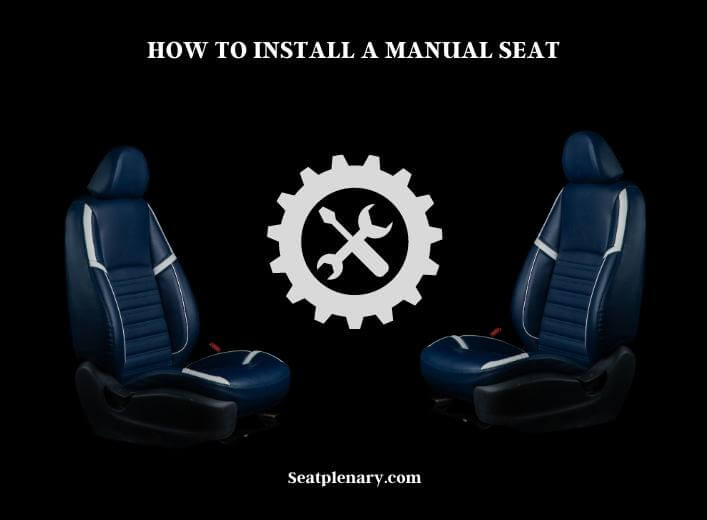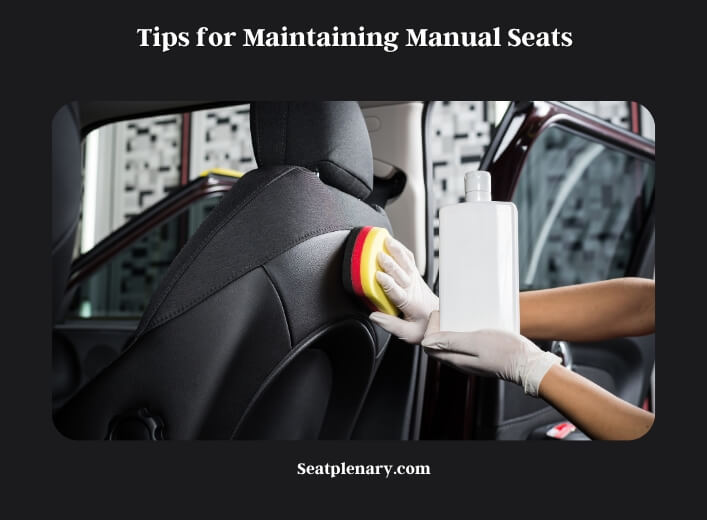When it comes to car seats, there are two main categories: manual seats and power seats. While power seats have become increasingly popular over the years due to their convenience and ease of use, manual seats still have the advantages that make them a great option for many drivers.

Manual seats are car seats that are manually operated, meaning they are adjusted using levers or knobs instead of electronic motors. These types of seats have been around for decades and were the standard option in cars before the introduction of power seats. However, despite the advancement of technology, manual seats still have several benefits that make them a great option for many drivers.
Types of Manual Seats
Manual seats come in a variety of types, each with its own unique features and benefits. Below are some of the most common types of manual seats found in cars:
Bench Seats
Bench seats are one of the oldest and most traditional types of car seats. They are typically found in older cars or in larger vehicles, such as pickup trucks, vans, or SUVs. Bench seats are designed to accommodate multiple passengers and offer a continuous seating area without any gaps between seats. This makes them a popular choice for families or for those who need to transport large items.
Bucket Seats
Bucket seats are a popular choice for sports cars or vehicles with a sporty feel. They are designed to offer maximum comfort and support to the driver and front passenger. Bucket seats have a curved backrest that wraps around the driver or passenger, providing a snug fit that keeps the occupant in place during sharp turns or quick stops. They also offer a more stylish and personalized look to the car’s interior.
Split-Bench Seats
Split-bench seats are a combination of bench seats and bucket seats. They are designed to accommodate both the driver and front passenger while also offering a center seat for a third passenger. Split-bench seats typically have a fold-down center console that can be used as an armrest or storage space.
Folding Seats
Folding seats are designed to provide additional cargo space when needed. They can be found in the rear of station wagons, SUVs, and minivans. Folding seats can be folded down flat or partially to provide more space for luggage or other large items.
Reclining Seats
Reclining seats offer adjustable backrests that can be tilted forward or backward for maximum comfort. They are a popular choice for long-distance driving or for those who suffer from back pain.
Each type of manual seat has its own set of advantages and disadvantages, so it’s important to choose the right type of seat for your needs. Consider factors such as the car model, the number of passengers, and the level of comfort and support required when selecting a manual seat for your vehicle.
How to Choose the Right Manual Seat
Choosing the right manual seat for your car can be a daunting task, especially with so many options available. Here are some factors to consider when choosing the right manual seat:
Size and Fit
One of the most important factors to consider when choosing a manual seat is the size and fit. Make sure the seat you choose is the right size for your body and provides the necessary support and comfort. You should also make sure the seat fits properly in your car and doesn’t interfere with other components or controls.
Material
Manual seats come in a variety of materials, including leather, cloth, and vinyl. Consider the pros and cons of each material before making a decision. Leather is durable and easy to clean, but it can be expensive. Cloth is comfortable and affordable, but it can stain easily. Vinyl is a good compromise between the two, but it may not be as breathable as other materials.
Adjustability
Manual seats come with different levels of adjustability, including height, angle, and distance from the steering wheel or pedals. Consider how much adjustability you need and make sure the seat you choose provides the necessary options for your comfort and safety.
Style and Design
Manual seats come in a variety of styles and designs to suit your preferences. Consider the overall look and feel of your car’s interior and choose a seat that complements it. You can also choose seats with added features, such as lumbar support or heating, to improve your comfort.
Price
Manual seats come in a wide range of prices, so consider your budget before making a decision. Keep in mind that a higher price doesn’t always mean better quality and many affordable options provide good value for your money.
How to Install a Manual Seat?
Installing a manual seat can seem like a daunting task, but with the right tools and instructions, it can be a simple process. Here are the steps you need to follow to install a manual seat:

Preparation and Tools
Before you begin installing your manual seat, make sure you have all the necessary tools and equipment. You’ll need a socket set, a wrench, a screwdriver, and a ratchet. You should also have the owner’s manual for your car to help you locate and remove the old seat.
Removing the Old Seat
To remove the old seat, locate the bolts or screws that hold it in place. These can be found on the floor or the side of the seat. Use the socket set or wrench to loosen the bolts and remove them. Then, carefully lift the old seat out of the car.
Installing the New Seat
Place the new seat into the car, making sure it lines up with the bolt holes on the floor. Insert the bolts or screws into the holes and tighten them with the socket set or wrench. Make sure the seat is secure and doesn’t wobble or move around.
Adjusting and Testing
Once the seat is installed, adjust it to the desired position. Use the levers or knobs on the seat to adjust the height, angle, and distance from the steering wheel or pedals. Sit in the seat and test it to make sure it’s comfortable and secure.
Tips for Maintaining Manual Seats
Maintaining your manual seats is important for keeping them in good condition and ensuring they last as long as possible.

Clean Regularly
Dirt and debris can build up on your manual seats over time, which can cause wear and tear. To prevent this, make sure to clean your seats regularly with a soft brush or vacuum cleaner. You can also use a damp cloth to wipe down the seats.
Use Seat Covers
Seat covers are a great way to protect your manual seats from spills, stains, and damage. They can be easily removed and washed, and they come in a variety of styles and materials to suit your preferences.
Avoid Sharp Objects
Sharp objects, such as keys or pens, can scratch or puncture your manual seats. To prevent this, make sure to keep sharp objects away from your seats and avoid placing heavy or sharp objects on them.
Lubricate Moving Parts
If your manual seat has levers or knobs that move, they may require lubrication from time to time to prevent them from sticking or becoming difficult to use. You can use a silicone spray or other lubricant to keep these parts moving smoothly.
Inspect Regularly
Inspect your manual seats regularly for any signs of wear and tear, such as rips, tears, or loose bolts. If you notice any damage, it’s important to have it repaired as soon as possible to prevent further damage.
Manual Seat Adjustments
Manual seat adjustments refer to the various ways in which the position of a car seat can be manually adjusted to provide optimal comfort and support while driving. Manual seat adjustments are typically made using levers or knobs located on the side or bottom of the seat, and they can include the following:
Height adjustment: This allows the seat to be raised or lowered to match the driver’s height, ensuring that they have a clear view of the road and can comfortably reach the pedals.
Angle adjustment: This allows the seat to be tilted forward or backward to match the driver’s preferred seating angle and posture, which can reduce fatigue and improve comfort during long drives.
Seatback adjustment: This allows the seatback to be adjusted forward or backward to match the driver’s preferred distance from the steering wheel and pedals, ensuring that they can easily reach and control these components.
Lumbar support adjustment: This allows the lumbar region of the seatback to be adjusted to provide additional support and reduce strain on the lower back.
Headrest adjustment: This allows the headrest to be adjusted to match the driver’s height and position, providing support for the head and neck in the event of an accident.
Proper manual seat adjustments are important for maintaining a comfortable and safe driving position. It’s recommended to adjust the seat before starting the car and to make adjustments as needed during long drives to prevent fatigue and discomfort.
Manual Lumbar Support
Manual lumbar support refers to a feature of some car seats that allows the user to manually adjust the amount of support provided to the lower back region of the seat. This feature is particularly useful for people who experience back pain or discomfort during long drives, as it can help to reduce strain on the lower back muscles and improve overall comfort.
Manual lumbar support is typically adjusted using a knob or lever located on the side of the seat or within the seatback itself. By turning the knob or lever, the user can increase or decrease the amount of support provided to the lumbar region of the seat. Some seats may also include inflatable or inflatable lumbar support cushions, which can be manually inflated or deflated to provide customer support.
Proper adjustment of manual lumbar support can vary depending on the individual’s preferences and needs. However, as a general rule, the support should be adjusted so that it fills the natural curve of the lower back and provides a comfortable, yet supportive, cushioning. It’s important to avoid over-adjusting the lumbar support, as this can cause discomfort or even exacerbate existing back pain.
Last Remarks
Manual seats are a great option for those who prefer a more hands-on approach to adjust their car seats. They are also typically more affordable than power seats and require less maintenance. However, choosing the right manual seat and installing it properly is important for ensuring your comfort and safety while driving.
When choosing a manual seat, consider factors such as size and fit, material, adjustability, style and design, and price. It’s also important to properly install the seat according to the manufacturer’s instructions and maintain it regularly for optimal performance.
